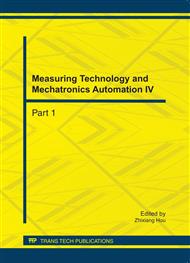p.584
p.589
p.594
p.602
p.607
p.611
p.616
p.620
p.625
Inter-Pulse Spectroscopy Based on Room-Temperature Pulsed Quantum-Cascade Laser for N2O Detection
Abstract:
Mid-infrared lasers are very suitable for high-sensitive trace-gases detection for their wavelengths cover the fundamental absorption lines of most gases. Quantum-cascade (QC) lasers have been demonstrated to be ideal light sources with its special power, tuning and capability of operating in room-temperature. All these merits make it appropriate for the high resolution spectrum analysis. The absorption spectrum monitoring technology based on the QC laser pulsed operating in the room temperature, combining with the strong absorption of the gas molecule in the basic frequency, has become an effective way to monitor the trace gas with the characteristic of high sensitivity, good selectivity and fast response. In this paper, the inter-pulse spectroscopy based on a room-temperature distributed-feedback pulsed QC laser was introduced. Our approach to trace gas monitoring with QC lasers relies on short current pulses which are designed to produce even shorter light pulses. Each pulse corresponds to a single point in a spectrum. The N2O absorption spectrum centered at 2178.2cm-1 was also obtained.
Info:
Periodical:
Pages:
607-610
Citation:
Online since:
October 2011
Keywords:
Price:
Сopyright:
© 2012 Trans Tech Publications Ltd. All Rights Reserved
Share:
Citation:


